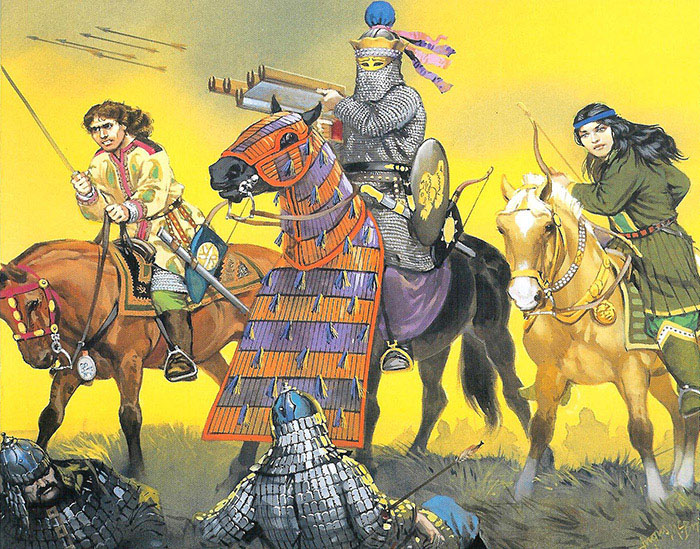
Several books (namely Kaveh Farrokh’s Sassanian cavalry
book) speak of the existence of a Sassanid weapon that could fire volleys of 5
arrows repeatedly, calling it “panjagan”.
The most unique of the auxiliary arms possibly carried by
the late clibanarii was the missile-launching device known as the panjagan,
meaning `five device’. The exact specifications of the invention are unknown
since there are no surviving remains but the written accounts state that the
contraption could fire five missiles at once. Therefore, heavy cavalrymen armed
with the missile weapon instead of the bow could not only fire many more shots
at a much higher rate, but they could also spread their fire over a wider area
as well. I wonder if the panjagan has anything to do with the nawak
arrow-guide, which allowed Sassanids to fire projectiles similar to crossbow
bolts from their bows with great range and accuracy. Arabs claim it was also
very effective against armor.
To ensure greater speed and volume, a device was invented
known as the panjagan (five device), allowing the knight to fire five shots
with a single draw. This made archery particularly deadly, since an archer
could fire five more arrows before the first set had reached its target. This implies
that the arrows must have been prearranged for rapid access in groups of five
in the quiver, contrasted to the regular Sassanian way of holding three arrows
in the same hand as the bow. However, it is important to note that speed and
volume of delivery were not the sole intentions of this weapon. Focused fire
was another. It is likely that the panjagan allowed for the volley to spread
over an intended area, creating localized “kill zones.” This allowed
fewer people to concentrate “focused fire” on the enemy. No known
actual samples of the panjagan have survived.
A translation of part of al-Tabari’s History (C. E. Bosworth
(trans.), The History of al-Tabari, Vol. 5, The Sassanids, the Byzantines, the
Lakmids, and Yemen, New York, 1999).
The story is that, in about AD570, the Sassanid king Khusraw
I sent a force to Yemen to liberate it from the domination of the Abyssinians.
This force originally numbered 800 men but 200 were lost at sea on the way. It
was commanded by noble named Wahriz who Khusraw considered to be worth 1000
cavalrymen. On arrival, the force was joined by “a considerable number of
people” but it was vastly outnumbered by the Abyssinian army sent against
it. This army was commanded by the Abyssinian governor of Yemen, Masruq. Before
the battle, Wahriz addressed his troops:
He ordered them to have their bows bent and strung, and
said, “When I give you the order to shoot, let fly at them swiftly with a
five-arrow volley (bi-al-banjakan).” (op. cit., p.247)
There is a footnote to this passage as follows:
This seems to be the meaning here, since Persian panj,
“five,” is clearly an element of the word, presumably panjagan,
“five-fold,” in origin. It is presumably related to the banjakiyyah
of al-Jawaliqi, al-Mu’arrab, 71: a volley of five arrows, mentioned in a
context which speaks of the Khurasanians. Siddiqi, Studien über die persischen
Fremdwörter, 81 n.7, less plausibly interprets banjakan as referring to
five-pointed or five-barbed arrows (“fünfzackige [Pfeile]”).
The battle was short-lived:
He then took an arrow, placed it in the center (kabid) of
his bow and said, “Point out for me Masruq.” They did that for him,
until Wahriz was sure of him, and then he gave the order “Shoot!” He
himself pulled on his bow until, when he had drawn it to its utmost, he
released the arrow. It sped forward as if it were a tightly stretched rope, and
struck Masruq’s forehead. He fell from his mount. A great number of men were
killed by that rain of arrows. When they saw their commander felled to the
ground, their front rank crumbled, and there was nothing for it but flight.(op.
cit., p.248)
It seems from this passage that the panjagan was not a
mechanical device but a rapidly-shot volley of five arrows. It is somewhat
reminiscent of the “Mad Minute”, whereby the British infantry before
the First World War was trained to fire fifteen aimed rounds in a minute.